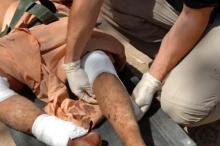Suicide bombs have now killed 200 coalition soldiers and more than 12,000 civilians in Iraq, say the authors of a new report focusing on the high number of civilian deaths – particularly child deaths – and injuries from such attacks.
The report, published online Sept. 1 in the Lancet, shows that while U.S.-led coalition forces have adopted successful strategies for avoiding suicide bomb attacks and for treating its own members exposed to them, the noncombatant, civilian population of Iraq has borne a remarkably heavy burden (Lancet 2011;378: 906-14).
Some 30,644 noncombatant civilians were injured and 12,284 killed in more than 1,000 suicide bombings between March 2003, when the Iraq war began, through the end of December 2010 – a ratio of 2.5 injured for every 1 killed, investigators found. Some 19% of all Iraqi civilian casualties and 11% of Iraqi civilian deaths in this period were caused by suicide bombs, with car bombs proving more lethal than those detonated by bombers on foot.
 Courtesy U.S. Army/Pfc. Charles Probst
Courtesy U.S. Army/Pfc. Charles Probst
U.S. Army Soldiers of 3rd Squadron, 2nd Cavalry Striker Regiment provide medical treatment to Iraqi civilians on Forward Operating Base Normandy, Iraq, April 4, 2008. The Iraqis were injured by a suicide bomb in Hamrin, Iraq, which killed seven people and wounded 33. (U.S. Army photo by Pfc. Charles Probst) (Released)
"I think everyone knows that civilians are more exposed to suicide bombs, but the extent to which that’s true was surprising," the study’s lead author, Dr. Madelyn Hsiao-Rei Hicks of King’s College London, said in an interview.
The study by Dr. Hicks and her colleagues also revealed Iraqi children to be particularly vulnerable. Children comprised 14% of suicide bomb fatalities during the study period – a share greater than the 9% dying in all forms of armed violence – and 51% of child casualties from suicide bombs were fatal.
Contributing factors may have included malnutrition, a scarcity of pediatric experts and supplies in clinics, more severe injuries, and greater physiological vulnerability to the type of injuries caused by suicide bombs, Dr. Hicks and her colleagues wrote.
While earlier, smaller studies have suggested that children are more vulnerable to suicide bombs, "I hadn’t seen that before in larger sets of data on children and adults," Dr. Hicks said. "It makes sense anatomically, as their heads and torsos are proportionately larger than adults’, and a bomb is more likely to hit a vital organ."
Why Suicide Attacks Focus on Iraqi Civilians
In an editorial comment accompanying the article, Dr. Gilbert Burnham of Johns Hopkins Bloomberg School of Public Health, Baltimore, offered a broader perspective on why Iraq’s civilian population would bear such a disproportionate brunt of such attacks, and what might be done about it (Lancet 2011;378:855-7).
"Prevention of suicide attacks is difficult because of their complex origins," Dr. Burnham wrote. "The military’s approach of controlling access and attacking suspicious targets has protected coalition forces in Iraq, but the resulting deaths of innocent civilians have alienated many Iraqis. This action has played a part in shifting suicide attacks towards civilian targets."
Attempts to stop bombers are often futile, Dr. Burnham continued. "Most effective is the elimination of conditions that cause popular support for terrorist groups," and targeting of extremist networks.
Dr. Burnham declared that he had no conflicts of interest. Dr. Hicks and colleagues declared that they had no financial conflicts of interest; however, their study, which had no outside funding, used data from Iraq Body Count, an organization founded by three of Dr. Hicks’ coauthors. Dr. Hicks serves as an unpaid director for IBC.
Dr. Hicks said that she had become involved with IBC after discovering that its database contained valuable public health information gotten through exacting methods. Moreover, she said, IBC distinguished between civilians and combatants, which many data sources do not, and had information on specific types of weapons involved in the injuries. "It's the kind of detail that’s very difficult to obtain in clinical settings," she said.
IBC has documented violent deaths of Iraqi civilians since 2003, using media, hospital, government and nongovernmental organization reports. Dr. Hicks and her colleagues also used data from iCasualties, a separate group that tracks coalition military casualties in Iraq and Afghanistan.
While the investigators acknowledged that one potential weakness of their study was its use of a database reliant on media reports, they noted that all IBC’s reports had been cross-checked and represented "documented, verifiable, individual casualties and suicide bomb events," not estimates or extrapolations.
The study appeared as part of a group of articles in the Lancet highlighting the health consequences of actions and conflicts in the decade following the terrorist attacks of Sept. 11, 2001.
